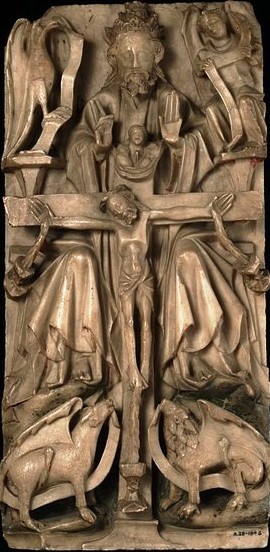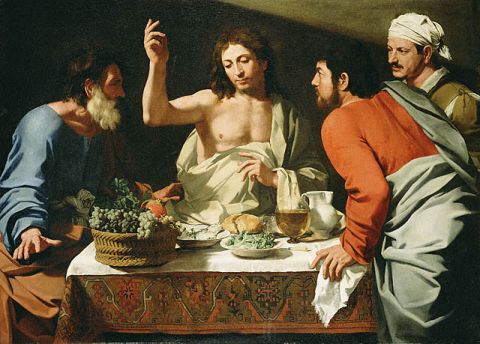The Unsurpassed Power and Effectiveness of the Prayer of Christ - Divine Office IV
 The Liturgy is the most powerful and effective form of prayer. This is the fourth in a series on the Liturgy of the Hours. The others are here. The Liturgy (the Mass and Liturgy of the Hours) is not just powerful and effective. It is the most powerful and effective action of the Church on our behalf. Christ participated in it historically; and continues to do so eternally in heaven and on earth and we participate in His prayer through his mystical body, the Church.
The Liturgy is the most powerful and effective form of prayer. This is the fourth in a series on the Liturgy of the Hours. The others are here. The Liturgy (the Mass and Liturgy of the Hours) is not just powerful and effective. It is the most powerful and effective action of the Church on our behalf. Christ participated in it historically; and continues to do so eternally in heaven and on earth and we participate in His prayer through his mystical body, the Church.
I have assumed that as a devout Jew, Christ participated in the Jewish liturgy, which followed a pattern of marking the hours, either three or seven times a day (and once at night) and praying the psalms (which is the basic form of the Liturgy of the Hours). The bible speaks of this pre-Christian practice and its continuation in the Church that He founded (see here) ; and we know from historical records that this tradition has continued to the present day. A lovely example that illustrates this continuation of the thread of tradition is the psalm tune or 'tone' called the Tonus Perigrinus. This came from the ancient tradition of the synagogue, was passed on to the Christian liturgy and became one of the standard chants of Gregorian chant. It has become one of the standard chants of Anglican chant too (listen here).
 When we pray with the Church, we pray as part of the mystical body of Christ who is our priestly advocate to the Father. Liturgy (the Mass and the Liturgy of the Hours) is the worship of the Father, through the Son, in the Spirit. It is the means by which we enter into a profound relationship with God and enter directly into the dynamic mystery of love of the three persons of the Trinity. In doing so we become divine, yes divine. This is the source of power and effectiveness, and joy. This union with God is why God created us, and God became man to allow this to happen:
When we pray with the Church, we pray as part of the mystical body of Christ who is our priestly advocate to the Father. Liturgy (the Mass and the Liturgy of the Hours) is the worship of the Father, through the Son, in the Spirit. It is the means by which we enter into a profound relationship with God and enter directly into the dynamic mystery of love of the three persons of the Trinity. In doing so we become divine, yes divine. This is the source of power and effectiveness, and joy. This union with God is why God created us, and God became man to allow this to happen:
'The Word became flesh to make us "partakers of the divine nature": "For this is why the Word became man, and the Son of God became the Son of man: so that man, by entering into communion with the Word and thus receiving divine sonship, might become a son of God." "For the Son of God became man so that we might become God." "The only-begotten Son of God, wanting to make us sharers in his divinity, assumed our nature, so that he, made man, might make men gods."81 (Catechism of the Catholic Church, 460, quoting 2 Pt 1:4; St. Irenaeus in the second century AD; and St Athanasius in the 4th century AD; and Jn 1:14)
 ‘Christ Jesus, high priest of the new and eternal covenant, taking human nature, introduced into this earthly exile that hymn which is sung throughout all ages in the halls of heaven. He joins the entire community of mankind to Himself, associating it with His own singing of this canticle of divine praise. For he continues His priestly work through the agency of His Church, which is ceaselessly engaged in praising the Lord and interceding for the salvation of the whole world. She does this, not only by celebrating the eucharist, but also in other ways, especially by praying the divine office.’ (Sacrosanctum Consilium, 83; written in 1963)
‘Christ Jesus, high priest of the new and eternal covenant, taking human nature, introduced into this earthly exile that hymn which is sung throughout all ages in the halls of heaven. He joins the entire community of mankind to Himself, associating it with His own singing of this canticle of divine praise. For he continues His priestly work through the agency of His Church, which is ceaselessly engaged in praising the Lord and interceding for the salvation of the whole world. She does this, not only by celebrating the eucharist, but also in other ways, especially by praying the divine office.’ (Sacrosanctum Consilium, 83; written in 1963)
If we are participating in the divine nature (albeit at this stage only temporarily and by degrees for us as individuals) it is no wonder that this prayer is powerful.
'Accordingly, every liturgical celebration, as an activity of Christ the priest and of his body, which is the Church, is a sacred action of a pre-eminent kind. No other action of the Church equals its title to power or its degree of effectiveness.' (Sacrosanctum Consilium, 7, [my emphasis])
Those who want to learn to do the Divine Office, you might approach a priest or religious (ie monk or nun) and ask them to show you. Alternatively, the Way of Beauty summer retreats at Thomas More College of Liberal Arts will teach you how to pray the Liturgy of the Hours and how you can realistically incorporated it into a busy working or family life
Images from top: anonymous, Christ Pantocrator, Monreale, Sicily, 12th century; anonymous, 'Mercy Seat' Trinity with four evangelists, English alabaster, early 15th century; Duccio, detail, showing the Agony in the Garden of the Maesta, 14th century;
Images below text: Bartolomeo Cavarozzi (1590 - 1625), Supper at Emmaus. The artist was an Italian who lived in Spain; Rembrandt, Supper at Emmaus

